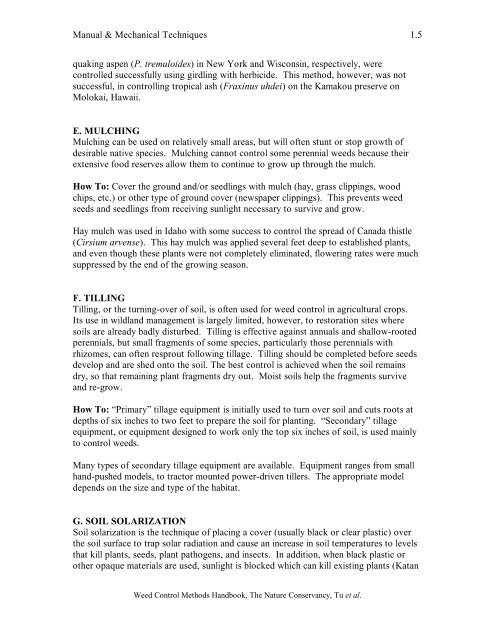Weed Control Methods Handbook: Tools ... - Invasive.org
Weed Control Methods Handbook: Tools ... - Invasive.org
Weed Control Methods Handbook: Tools ... - Invasive.org
Create successful ePaper yourself
Turn your PDF publications into a flip-book with our unique Google optimized e-Paper software.
Manual & Mechanical Techniques 1.5<br />
quaking aspen (P. tremuloides) in New York and Wisconsin, respectively, were<br />
controlled successfully using girdling with herbicide. This method, however, was not<br />
successful, in controlling tropical ash (Fraxinus uhdei) on the Kamakou preserve on<br />
Molokai, Hawaii.<br />
E. MULCHING<br />
Mulching can be used on relatively small areas, but will often stunt or stop growth of<br />
desirable native species. Mulching cannot control some perennial weeds because their<br />
extensive food reserves allow them to continue to grow up through the mulch.<br />
How To: Cover the ground and/or seedlings with mulch (hay, grass clippings, wood<br />
chips, etc.) or other type of ground cover (newspaper clippings). This prevents weed<br />
seeds and seedlings from receiving sunlight necessary to survive and grow.<br />
Hay mulch was used in Idaho with some success to control the spread of Canada thistle<br />
(Cirsium arvense). This hay mulch was applied several feet deep to established plants,<br />
and even though these plants were not completely eliminated, flowering rates were much<br />
suppressed by the end of the growing season.<br />
F. TILLING<br />
Tilling, or the turning-over of soil, is often used for weed control in agricultural crops.<br />
Its use in wildland management is largely limited, however, to restoration sites where<br />
soils are already badly disturbed. Tilling is effective against annuals and shallow-rooted<br />
perennials, but small fragments of some species, particularly those perennials with<br />
rhizomes, can often resprout following tillage. Tilling should be completed before seeds<br />
develop and are shed onto the soil. The best control is achieved when the soil remains<br />
dry, so that remaining plant fragments dry out. Moist soils help the fragments survive<br />
and re-grow.<br />
How To: “Primary” tillage equipment is initially used to turn over soil and cuts roots at<br />
depths of six inches to two feet to prepare the soil for planting. “Secondary” tillage<br />
equipment, or equipment designed to work only the top six inches of soil, is used mainly<br />
to control weeds.<br />
Many types of secondary tillage equipment are available. Equipment ranges from small<br />
hand-pushed models, to tractor mounted power-driven tillers. The appropriate model<br />
depends on the size and type of the habitat.<br />
G. SOIL SOLARIZATION<br />
Soil solarization is the technique of placing a cover (usually black or clear plastic) over<br />
the soil surface to trap solar radiation and cause an increase in soil temperatures to levels<br />
that kill plants, seeds, plant pathogens, and insects. In addition, when black plastic or<br />
other opaque materials are used, sunlight is blocked which can kill existing plants (Katan<br />
<strong>Weed</strong> <strong>Control</strong> <strong>Methods</strong> <strong>Handbook</strong>, The Nature Conservancy, Tu et al.
















